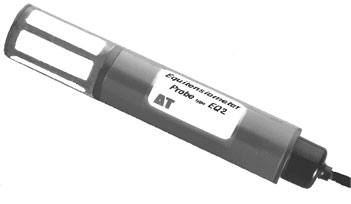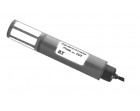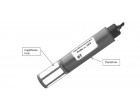
Equitensiometer :
The Equitensiometer measures soil matric potential - that is the negative pressure (or suction) required to extract water from between the matrix of soil particles. It is an important indication of plant water stress. The value of soil matric potential measured depends mainly on the quantity of water present and the make up of the soil, though it is also affected by temperature and salinity.
The Equitensiometer consists of a precision soil moisture sensor (the ThetaProbe) whose measuring rods are embedded in a porous material (the equilibrium body). This material has a known, stable relationship between water content and matric potential. When the probe is inserted into the soil, the matric potential within the equilibrium body rapidly equilibrates to that of the surrounding soils. The water content of the matric material is measured directly by the ThetaProbe, and this can be converted into the matric potential of the surrounding soil using the calibration curve supplied with each Equitensiometer.
Advantages
Based on the ThetaProbe Soil Sensor, the EQ2 avoids the familiar problems of water-filled tensiometers. The ThetaProbe pins are embedded into a specially formulated porous matric material. Being maintenance free, (i.e. no refilling, degassing or topping up required) and low power, the EQ2 Equitensiometer can be conveniently used at remote sites. It is not harmed by frost, nor by long term burial.
Applications
The EQ2 Equitensiometer's full range is 0 to -1000 kPa but best accuracy is achieved between -100 and -500 kPa. This makes it well suited to plant water stress studies - even in very dry soils. However, the EQ2 should not be seen as a rapid response, high accuracy device covering the full range of matric potentials, as such a sensor does not yet exist. EQ2 equilibration time is typically several days. Extension Tubes can be used to position EQ2s at depth
.Data Logging
The EQ2 Equitensiometer is compatible with all Delta-T data loggers (GP2, GP1, DL2e or DL6). Each sensor is supplied with a unique calibration and the user enters the linearisation table into the logger’s software. (The DL2e Logger’s software also includes an alternative generic calibration that some users choose to use instead).








